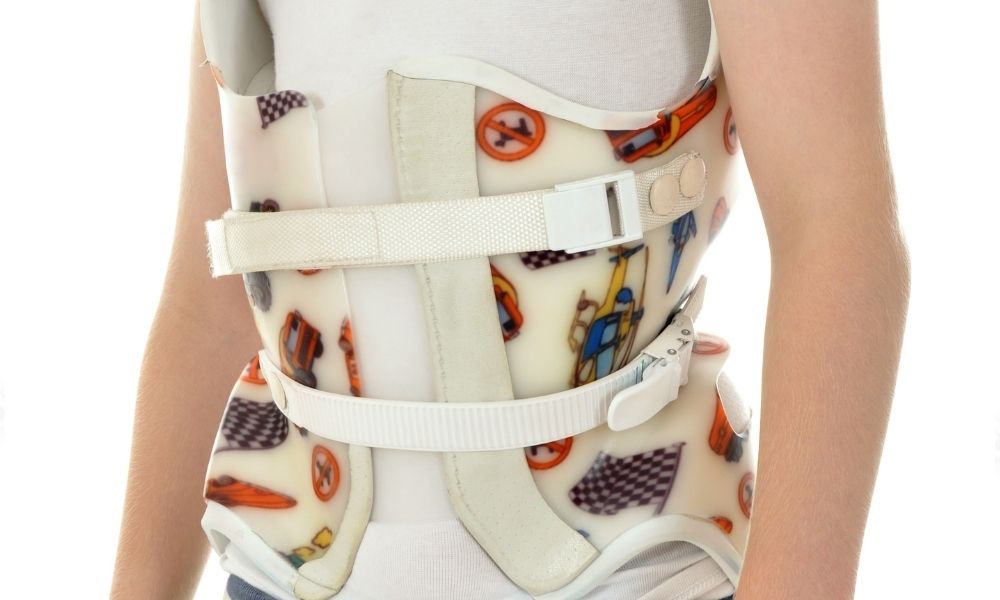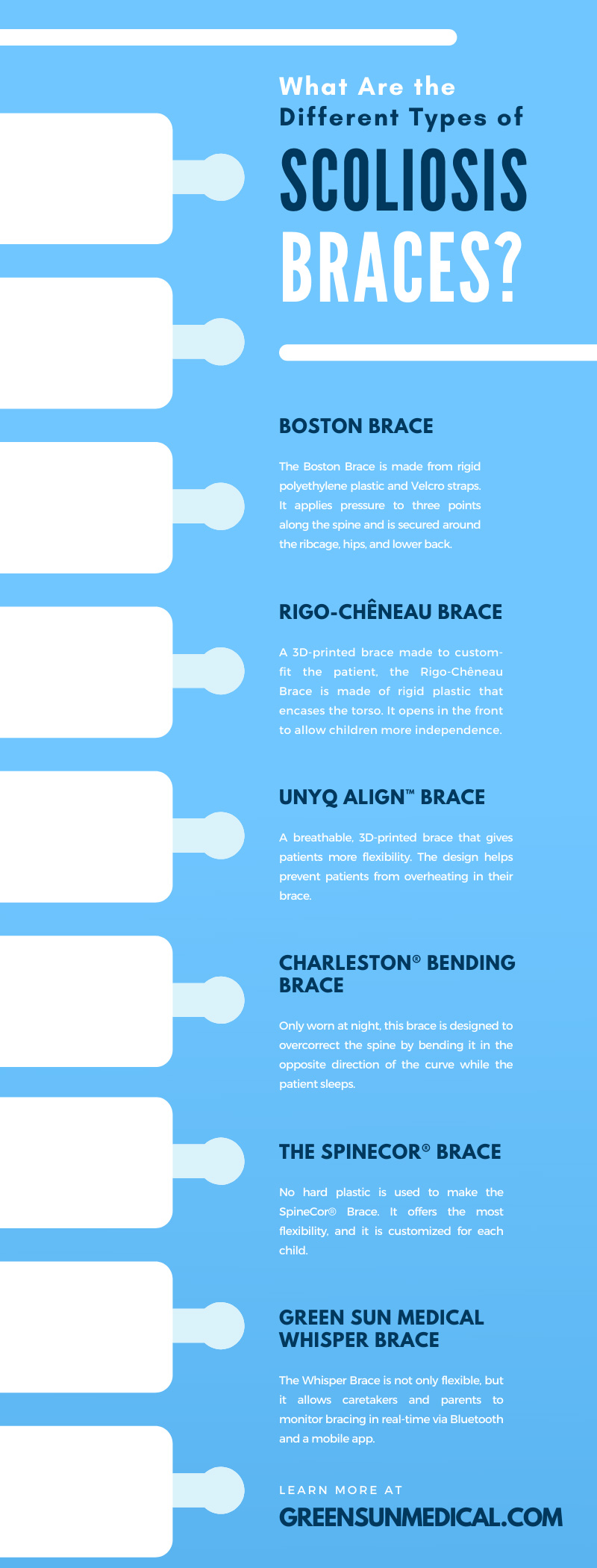You may not know what to expect after your child receives a scoliosis diagnosis. Doctors will monitor the progression of the curve and may recommend bracing if it becomes severe enough. But what are the different types of scoliosis braces? Be prepared to talk to your doctor by learning more about bracing.
What Is a Scoliosis Brace?
Scoliosis is a common condition in children that causes the spine to twist and curve. If it progresses past a mild case, bracing is often effective. Scoliosis braces are designed to slow the progression of the spinal curve when worn correctly. Patients wear the brace around the waist during stages of rapid development to help correct the curve.
When Do Doctors Recommend Bracing?
It’s important to detect scoliosis and begin treatment as soon as possible. Signs of childhood scoliosis often emerge around age 10 to 12. Typically, braces are only prescribed for patients whose spines curve 25 to 40 degrees. Less severe curves are managed with observation, while more severe curves may require surgery.
Reasons Bracing Is Effective
We’ve been using braces for hundreds of years to treat scoliosis. Though it’s not a cure, it can stop the progression of a curve. If caught in time, a brace may improve a patient’s way of life before scoliosis can cause additional problems.
How Bracing Works
Scoliosis braces work by putting pressure on the spine to correct the curve. Specific braces are designed for different types of curves. Patients receive x-rays to help determine the shape and size of their brace. Rigid braces put pressure on the convex part of the spine to hold their back in a straighter posture. Some patients must wear their brace for 16 to 23 hours per day.
Types of Scoliosis Braces
Scoliosis brace types have evolved over the years. Different types of braces are designed for patients of varying ages, body types, and whose conditions vary in severity. Some braces are more flexible than others, and some are designed to be worn at different times of day. Still, certain braces are designed for specific types of curves. Talk to your doctor about which is your best option.
Boston Brace
The most prescribed brace for scoliosis is a TLSO (Thoraco-Lumbo-Sacral-Orthosis), also known as the Boston Brace. It came out in 1972, replacing the Milwaukee Brace, which was mostly made of metal. The Boston Brace is made from rigid polyethylene plastic and Velcro straps. It applies pressure to three points along the spine and is secured around the ribcage, hips, and lower back.
Pro Tip: You can customize this brace with different colors and patterns. You can even add stickers to personalize it and make it your own.
Rigo-Chêneau Brace
A 3D-printed brace made to custom-fit the patient, the Rigo-Chêneau Brace is made of rigid plastic that encases the torso. It opens in the front to allow children more independence by being able to take it off and put in on their own. The plastic parts are customizable, so you can change the color.
Green Sun Medical Whisper Brace
Since rigid braces are uncomfortable, doctors have started switching some patients to flexible designs that are easier to wear all day. The Whisper Brace is not only flexible, but it allows caretakers and parents to monitor bracing in real-time via Bluetooth and a mobile app.
UNYQ Align™ Brace
A breathable, 3D-printed brace that gives patients more flexibility. The design helps prevent patients from overheating in their brace.
The SpineCor® Brace
No hard plastic is used to make the SpineCor® Brace. It offers the most flexibility, and it is customized for each child.
Charleston® Bending Brace
Only worn at night, this brace is designed to overcorrect the spine by bending it in the opposite direction of the curve while the patient sleeps. It’s terribly uncomfortable to walk, stand, or sit in this position, so this treatment is applied while the child is lying down.
Full-Time vs. Nighttime Braces
There are two different types of braces for scoliosis: full-time and nighttime. Full-time braces are worn day and night, while nighttime braces are only worn while lying down. Some patients with scoliosis may only brace at night. Since nighttime braces are rigid and overcorrect the spine, they offer more intense treatment than full-time braces. Still, full-time braces offer support throughout the day and are more comfortable than nighttime bracing.
How To Care for Your Brace
Whether you use a full-time or nighttime brace, it’s important to take good care of it. Each day, you should wipe it down with an antibacterial cleanser. Wash the entire device with soap and water once each week to remove dirt and skin cells.
Care for Your Skin
Skincare is essential when wearing a scoliosis brace. Rashes and sores may develop if you don’t take proper steps to manage your skin. Essential tips to keep in mind include:
- Always wear a tight, thin layer between your skin and the brace.
- If you notice a red spot on your skin that doesn’t go away after you remove the brace, you may need an adjustment.
- Use rubbing alcohol on the parts of your skin that the brace touches for two to three weeks to strengthen it.
- Bathe daily.
- Keep your brace dry while you’re wearing it.
- Wear the brace as snug as possible.
What To Expect From Bracing
Using a brace to treat scoliosis won’t cure the condition. While it can’t straighten the spine, it may slow or stop the progression of the curve. Patients are expected to wear full-time braces for most of the day and must wear them until their bones stop growing. Adolescents usually wear their braces for up to 23 hours per day. Patients who begin treatment before age 12 may brace for at least three to four years.
Accepting Brace Wear
Many children have a difficult time accepting their condition and the treatment that follows. They may feel embarrassed or ashamed to wear a brace in public or for their friends to know. As a parent, you can help by letting them pick out clothes to complement their brace. Further, let them oversee who and how they tell people.
Pro Tip: Encourage your child to let their friends and family know about their treatment. Loved ones will be supportive and want to help when needed.
Knowing what the different types of scoliosis braces are can help you prepare for a possible diagnosis and treatment recommendation. You won’t be surprised when your doctor prescribes a Boston Brace, and you can ask about more flexible options like the Whisper Brace if you think your child will be too uncomfortable wearing a less flexible brace. Talk to your child about their options and support them through their recovery.


